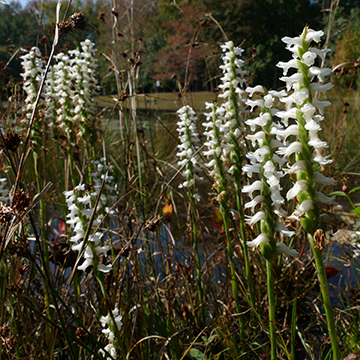

Spiranthes bightensis - (image 1 of 5)
Taxonomy
Family: Orchidaceae
Habitat
Wet to moist, short-statured, rarely brackish, open graminoid-cyperoid meadows, maritime dune swales, Sphagnum dominated freshwater lake and pond edges, and roadsides; occasionally periodically shallowly inundated.
Associates
Distribution
Mid-Atlantic Bight and New York Bight from the southern Hudson River estuary and Long Island, New York, to the Delmarva Peninsula of Maryland and Virginia.
Morphology
Perennial to 100 cm. Roots slender, stoloniferous. Leaves 15, basal, held upright, remaining until after anthesis, lanceolate, 1521.4 cm long, 1.41.7 cm wide. Trichomes capitate and glandular. Spike robust, thickened, a tightly coiled spiral (appearing as 34 ranks), moderately to densely pubescent. Floral bracts pubescent, 11.822.6 mm long. Flowers campanulate, slightly nodding, white to pale ivory, lightly to strongly fragrant with a scent varying from general floral to vanilla-jasmine. Sepals moderately to densely pubescent. Dorsal sepal apically slightly to strongly recurved, concave, lanceolate, 8.311.7 mm long when flattened. Lateral sepals lanceolate, acute, very slightly upwardly falcate, slightly ascending, the apices often incurved, surpassing the dorsal sepal and petals, 9.211 mm long. Dorsal petals slightly concave, lanceolate, bluntly acute, slightly to strongly recurved at tips, with the dorsal sepal appearing stellate, 9.511 mm long when flattened. Labellum recurved strongly downward at about 1/3 the distance from the claw to labellum apex, centrally glabrous, upper margin entire to very slightly undulating becoming shallowly laciniate to lacerate towards the apex, centrally white to pale yellow, 7.712.2 mm long, 3.05.5 mm wide at the area of recurvature when flattened, apex acuminate; callosities/nectar glands, white to pale yellow, conical, upright, 12 mm tall. Column 4.16 mm long, apex truncate, column foot stout; rostellum 1.21.5 mm long; viscidium linear, 11.8 mm long. Ovary moderately to densely pubescent.
Notes
Flowers late September to early November.
Wetland indicator: NA
This species is apparently the result of hybridization of S. cernua with S. odorata. It has long been known in cultivation as the cultivar 'Chadds Ford', which was attributed to either S. odorata or the illegitimate name S. cernua var. odorata. It is a robust plant that reproduces rapidly via stoloniferous roots, allowing for rapid propagation. This trait is not limited to the original cultivar that was collected in Delaware by Dick Ryan in the 1960's, and plants from southern NJ show the same propensity for vegetative reproduction.
Previous reports of S. odorata in NY were based on collections in 1896 and 1905 from Hempstead Long Island, Nassau County by Fanny Mulford, currently housed at the NY Botanical Garden (McMullen et al. 2021). Sheviak (1982) discussed one of these collections as a possible indication of gene flow. He annotated the 1896 specimen as S. cernua and on the 1905 specimen states that it suggests S. odorata in gross morphology but is certainly not typical, and that it may be this species at its northern limit or the result of gene flow from S. odorata to S. cernua.
Based on examination of plants from two populations in southern NJ, it appears that S. bightensis can exhibit prominent abaxial labellum glands as in many other members of the Spiranthes cernua species complex, unlike S. cernua which typically has reduced and flattened glands. Spiranthes bightensis also tends to have wider leaves (1.4 + cm) than S. cernua. These traits may be useful for distinguishing the two species.
References
McMullen, J.M., M. Hough, M.A. Young, and C.L. Landis. 2021. Discovery of Spiranthes odorata (Nutt.) Lindl. (fragrant ladies-tresses) in central New York. Native Orchid Conference Journal 18(2): 38-50.
Pace, M.C. 2021. Spiranthes bightensis (Orchidaceae), a new and rare cryptic hybrid species endemic to the U.S. Mid-Atlantic coast. Phytotaxa 498(3): 159-176.
Pace, M.C. and Cameron, K.M. 2017. The systematics of the Spiranthes cernua species complex (Orchidaceae): Untangling the Gordian Knot. Systematic Botany, 42(4):1-30.
Sheviak, C.J. 1982. Biosystematic study of the Spiranthes cernua complex. New York State Museum Bulletin No. 448.
|
Michael Hough © 2021 |